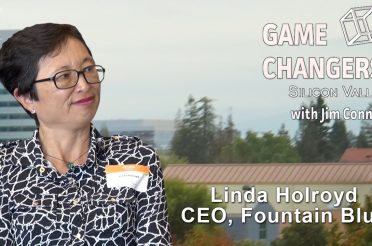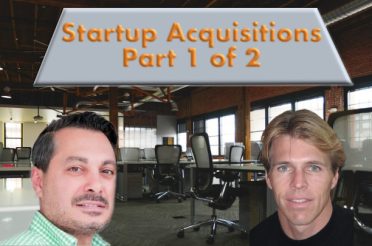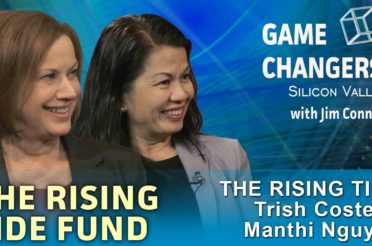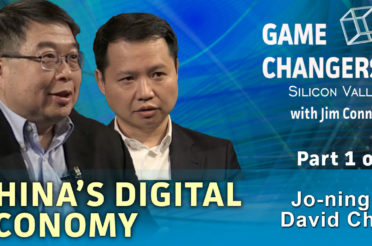Overview
The introduction of A2 Milk represents an innovation to eliminate milk-based allergens and lactose intolerance among consumers. It also represents one of the first of many innovations that are expected to come from the dairy sector. The Agtech movement is changing the way dairy products are produced and processed as well as innovations in milk-based foods. The Government of Ireland is looking for partners in Agtech who wish to be a part of this evolution.
 In this podcast, we will discuss how the government of Ireland, universities, research institutes, and the private sector are working together to enhance existing production methods as well as create entirely new products from milk as a primary ingredient..
In this podcast, we will discuss how the government of Ireland, universities, research institutes, and the private sector are working together to enhance existing production methods as well as create entirely new products from milk as a primary ingredient..
My guests are Maeve Cowley, Vice President of IDA Ireland and Mark Keane, Chair of the Computer Science Department at University College Dublin, and a Director at the Vista Milk Research Center. Click on the above podcast player to listen to the conversation about The Future of Milk.
Key Concepts
The depth and breadth of the Agtech movement are transforming many agriculture sectors. The dairy industry is a well-established industry that has received some productivity enhancements over the years. such as automated milking machines. Otherwise, the products and methods have remained the same over the decades and centuries.
The dairy sector is now going through a transformation in Ireland. Private industry and the government are making a move to apply 21st-century innovation and productivity enhancements to transform the entire dairy supply chain along with the products that are being produced.
The application of technology begins with the soil and research with predictive analytics on the growth of pasture grass. Cow identification adds efficiency for identifying which cows that have been milked, cows being treated for diseases, the age of the cows and the genetics of the cow.
Research on the proteins in milk helped to identify allergens affecting humans and lead to the identification of A1 versus A2 protein type milk and the genetics of cows producing both types of milk,
Research in Ireland continues with support from the government and industry.
Transcript
Jim Under the Agtech innovation umbrella, one of our most basic and essential food groups is undergoing a supply chain and product transformation. Milk and its various derivatives are the focus of funded research aimed at helping Ireland’s dairy sector create a range of new, innovative products.
We are continuing our focus on Agtech and today, we will discuss the supply chain transformation for one of our five basic and essential food groups. Milk and its various derivatives are the focus of funded research aimed at helping Ireland’s dairy sector create a range of new, innovative products.
Mark “One of the really big areas that I think is going to be very important is at the end of our supply chain we actually end up with nutrition and the body and we end up with the microbiome and we have a lot of people who are nutritionists and they’re looking at the impact of different proteins in milk on the human digestive system. Right. And so, for example, there’s a lot of work at the moment about producing a variant of milk that has less allergic proteins in it essentially it’s called A2 milk and you can actually breed cows that will produce more of that milk than the milk that is very allergen heavy as at were.”
Jim The government of Ireland is also on board, promoting the country’s resources to commercialize that research as well as to facilitate business development.
Maeve “We’re particularly interested in Agtech at the moment because technology is revolutionizing the agricultural industry and we see for those U.S. small and growing U.S. Agtech companies that they can use Ireland as a resource in particular if they’re interested in growing their kind of international revenues or developing innovative products. Ireland has the skills and the research base to enable them to do so.”
Jim My guests are Maeve Cowley, Vice President of IDA Ireland and Mark Keane, Chair of the Computer Science Department at University College Dublin, and a Director at the Vista Milk Research Center. Let’s join the conversation with Maeve and Mark about the Agtech innovation taking place in Ireland. So Maeve welcome to the show and Mark you’re currently in Ireland, Welcome to the show. Maeve let me start with you, IDA Ireland has been active in the Silicon Valley area and active in encouraging companies and IP development towards Ireland. Let me ask you to give us an overview of what your role is and what you’re trying to accomplish.
Maeve Well thanks, Jim. First of all for For inviting us along to talk about Ag and Ireland two of my favorite subjects. IDA Ireland as you rightly point out we’r the Inward Promotion Agency and we do FDI we promote Ireland as a place to locate. We partner with international companies as they evaluate and establish and grow their strategic sites in Ireland by providing facts providing funding of arranging site visits, providing property solutions and many of our services are absolutely free and they are all free actually. Agtech, we’re particularly interested in Agtech at the moment because technology is revolutionizing the agricultural industry and we see for those U.S. small and growing U.S. Agtech companies that they can use Ireland as a resource in particular if they’re interested in growing their kind of international revenues or developing innovative products. Ireland has the skills and the research base to enable them to do so.
Jim Great, So as I say I’ll summarize it. The big role that you play is helping companies here in the US expand into the European market going through Ireland and then also drawing upon the research facilities, intellectual horsepower if you will based in Ireland. Among the population.
Maeve Yes, So we tailor a lot of our services to exactly the needs of that community.
Jim So Mark welcome to the show from Ireland and you being a chair of the computer science department, let me ask you to give us an overview both of your role as computer science chair and as you’re and as a role in the Agtech movement.
Mark Well I guess we have quite a large operation in terms of the number of students that we have. We probably have Venter each of our undergraduate courses we’d have 100 to 150 students. We have about five or six hundred people in top master’s programs and maybe about 200 Ph.D.’s and a significant bunch of them that are in the data analytics, machine learning space. And of course, the work that I do in research terms is very much focused in this Vista Milk center which is a Science Foundation Ireland funded center working with the dairy sector to develop precision Ag for it.
Jim We have recently. Excuse me. We’d recently done a couple of shows about Ag tech and so I become more educated more informed. And it sounds like from what I’ve read here that this Vista Milk is quite an effort to transform the old way of producing milk and into an array of new products better technology that enhances not only the what did you say the sustainability of milk production as well as the new products that are used from milk. I mean I’ll let you give us an overview of that.
Mark Yeah, well I guess the good thing about Vista Milk is it works right across the supply chain for the dairy sector. So we start in the field with the soil and we model what’s going on in it. We then look at the grass and had that grass is growing. Then we move on to the cow when we see had the cow in a sense can be optimized genetically, often to process that grass and produce more milk from it. And then we end up in the factory dealing with their array of different products doing that can be produced from that milk, anything from baby formula to specific types of cheeses or other dairy products. And we’re essentially doing data analytics across all of that. And the point I’m making now lot more is that a lot of this is really about developing sustainable farming because the more efficiently you do these things, the less you pollute you know the less damage is done to the environment, and the better the products we get from it. So every enhancement we essentially do and data analytics has an upside it should have an upside both for a better product but also for minimizing the damage to the environment and of course the Irish dairy sector is a grass-fed or pasture-based herd as they say. So it’s very much based on a natural input product does it work. You know and that’s something which has been sold specifically now indeed in the US for Irish dairy products.
Jim You know as you speak are a couple of thoughts popped up in my mind. I didn’t have a chance to jot them down but I hope I’ll go back home and one is because the dairy industry milk production industry is so strong in Ireland and so complete in terms of the supply chain as you mentioned you have an opportunity to make multiple improvements and multiple innovations along that entire supply chain it’s not like you’re importing parts from another country or grain for that matter. You’ve got the entire supply chain at your fingertips and you’re moving forward in that area. And the other thing is the sustainability I really had overlooked and I’m aware that the cow industry or the dairy industry has lots of issues with sustainability mainly the waste but lots of other stuff too. But how the fields are treated and what’s in the milk per say, so not any anything that we are going to see or are seeing or about to see from your efforts coming out.
Mark Well just literally in the last four or five months we developed a new predictive model for grass growth. So one of the things that the national research body charges do is they provide a decision support system for farmers to estimate the grass production in the next week for their herd. Right now this is a very important estimate for a farmer because if they get it wrong then they have to go out and buy feed. If they buy feed you know that’s there’s lots of carbon costs in that but there are lots of direct costs as well. So we developed a new machine learning model that more accurately predict that. But it also explains the prediction which is made relative to the history of what occurred on that farmer’s farm in the past. So it means we can say to them you know next week is going to have this amount of of of grass. And by the way that’s exactly like last spring, you know in the second week of March or something like that.
Jim That’s a pretty interesting model. So I assume then you’re taking all the history but you’re also taking the weather forecasts into account things like that.
Mark And the location the weather what happened in that specific farm in the past and all of those variables.
Jim And you’re tracking the actual outcome also do shall we say have that artificial intelligence factor or machine learning factor into it. Is that correct?
Mark Yes. And we had to actually come up with really quite novel ideas in order to make that work as well. You know we use this sort of gold standard historical data which had been gathered on grass growth over 10 years. And that turned out to be a crucial sort of filter if you like for determining and making the prediction much more accurate. Now the thing about that is that you know that just doesn’t improve something for an individual farmer but it also means that that farmer knows, for example, the optimal amount of fertilizer they may need to use, it means it reduces their grain buying and stuff like that too. So this is what I mean by sustainability, not that farmer is gonna make more money, they’re gonna produce better milk but they’re gonna do it in a way which minimizes you know the impact to the environment as well.
Jim That’s great information. I appreciate that. Well said well well express so Maeve back to you then how does a company here in the U. What are the main motivations or main value propositions that you offer to a company in the U.S. you’ve mentioned revenue growth and then, of course, the research opportunities but how does that play out. Do they come to you first and what do you make introductions? I’m sure as people listening going Yeah kind of but thinking about that a little bit.
Maeve So let I think if any company is actually for any reasons interested in understanding how they can grow their international revenues in particular in Europe or developing innovative products within the ag sector. One of the things they should do is just type in IDA Ireland into the Google and come up with our Web site and you will be able to get contact details and have been in the Ag space you more than likely will end up talking with me or some of my colleagues across the globe depending where your based. And we can make an evaluation of where you are in that process and the kind of like the decision-making process we can help furnish you with some facts to for your cash desk research. But really the next step is kind of getting feet on the street going into Ireland and evaluating it for a location that you do what we would call a site visit and we will assist in setting that site visit up.
Jim I have to believe or hope I trust that there are specialties like you’re really great at something you know I know Agtech would be one. Yeah certainly I Agtech but maybe there are others like Life Science. Or.
Maeve Yeah well actually there are. There are We have several areas where we are very strong technology, consumer, and enterprise is one of our strongest sectors financial services and then pharma and BioMed would be the three large areas where Ireland is strong. But we see Agtech as an area that is evolving that can pull from a lot of the technical skills that we have residing inside those different sectors that are going to be applied to a new industry a latent industry if you like in agriculture that is transforming itself to meet the kind of like the drivers that Mark is talking about less sustainability and population growth.
Jim I do. I’m aware that Ireland plays a strong role in the financial services sector especially as a gateway to Europe and especially with the changes pending that are coming down the road here, with this whole Brexit probably even stronger role. Is that an area that is open for innovation or is it shall I say locked up by the big banks. I just have to ask you that question.
Maeve Well the financial service is not my area of expertise. However, there’s a significant number of fintech companies from the West Coast Stripe is an example of put the research and development labs into Dublin.
Jim So let me go back to an area that both of you can comment on. Mark, I’ll come back to you first. Tell me as you are involved both at the university level with students and the recruitment process essentially as well as this Vista Milk, what’s it like for a company, comes to American company we’ll say, comes to Ireland and begins to recruit. Is it easy? Are there other open recruitment centers, do universities facilitate this effort or you just to put ads in the paper or do you use things like you know job recruitment search engines.
Mark Yeah I mean it’s hard to sort of describe how active the environment is in Dublin now especially in the IT sector. You know I mean if you go down to could and you know the sort of Docklands area where there’s a huge amount of development of I.T. companies like Google have 6000 people down there now Accenture have an innovation lab but maybe 500 researchers. You have all of the main companies like Facebook, LinkedIn, you know you name it they’re all there and they’re there because there’s this very deep sort of level of expertise in all aspects of like running server farms you know doing A.I. doing machine learning and the technologies associated with that. It’s very very like the sort of San Francisco dynamic. You know it maybe doesn’t have I think the same V.C. base to it but it certainly has a very deep level of technical skill now and obviously the universities feed into all of that in a big way. But it’s not just supplied by Irish people like Dublin is a sort of, it’s a good place to live in as a young person you know and so we soak in a huge amount of people that are non-Irish as well in these sectors. So it’s just a good hiring ground and it’s quite unique. Now in a European context with respect to that, I think you know.
Maeve And beyond Dublin and there are significant cities. You know you got Cork you got Limerick you got Galway all kinds of major cities in and of themselves with well-developed ecosystems in the tech sector or the BioMed sector or the pharma sector. And if it comes to recruitment we would support companies, identify maybe recruitment companies or whatever there may be their own internal processes such that they would advertise directly and also we assist them with the PR and that helps get their near might and get them established possibly as an employer of choice that people will then voluntarily directly go to the company when they set up in let’s say Galway Limerick or Clark or Dublin or other places.
Jim I have to believe that it’s reasonably straightforward to get incorporated or become a legal entity in Ireland, but I’ll let you speak to that.
Maeve Yeah. So Ireland is a jurisdiction common law jurisdiction our employment legislation is very flexible and you know all we can provide all of those details to any potential investor and we can commit comparatives across other countries within Europe. You know again just type an IDAIreland.com and you’ll be able to get some contact details and you’ll end up speaking to someone like me who will be able to gauge you on that. It only takes a few days to set up a limited company. It’s very transparent. There’s minimum red tape and it’s a very connected environment.
Jim Good. Very good. So Mark let me come back to you because I am fascinated by the role you’re playing as both the university chair as well as running this Vista Milk. Are there lots of University Professors and Chairs running companies or are you the outlier.
Mark Well, so Vista Milk is is a research institute. Now it has very close connections to companies as well. And increasingly we have a research environment which has an awful lot of interaction with industry. In fact, we’re required to do it under the funding that we have, so a certain amount of the funding that we get government funding. But we have to attract funding from companies to match that funding essentially. And so that means that we’re very heavily involved in the enterprise ecosystem as it were. So, for example, Vista Milk has over 50 partners from the dairy sector involved in it that our companies raise.
Jim I recently did a show about the company that did license university technology, intellectual property and in fact and they talked about how the process worked and I wanted to ask you then. Relative to that process do you essentially have a mandate to license your technology for commercialization, in fact, there is a motivation to do that I assume. And how restrictive or how easy is it to do that. I’ll come to both of you on that.
Mark Yeah well there is there’s actually a national protocol on how this is done that governs all of the interactions now and that’s sort of good because it means that everyone knows there’s a standard contract as word a dude you develop when you start talking to a company right. Now essentially, I won’t go into the details about it, but the essence of it is that if the company is paying for it they get to own it. But if the company is benefiting from government money and that then the university owns it. But there’s a lot of pressure on us to license that as part of the agreement and we agree that upfront exactly how that licensing Agreement might work. And so the company knows what they will get out of that research in collaboration when it finishes.
Jim This is a fascinating area because the terms of the licensing are very very negotiable and If you know frankly I’m going to tell you what I see as terms here that there’s a no money upfront or very small money upfront to initiate the license but then once a company becomes either a certain revenue model or certain revenue number or profitable then they start to pay a royalty of roughly 3 to 5 percent perpetually. Sometimes it’s on revenues sometimes on net profit typically it’s going gonna be against revenues I assume. So do you have similar models and similar options in that way?
Mark Yeah exactly. And like for example I don’t know if you remember a mad cow disease and that but that the first test for mad cow disease was developed in UCD and the guy that developed that obviously ended up meeting making quite a lot of money in terms of royalties from it and it was licensed to a number of Irish companies that developed the test and sold it.
Maeve So more broadly speaking of companies are interested in research and development and thus intellectual property might drop out of that they can get research and development grants from I DA Ireland and then that sits within a kind of like an R&D tax credit base within Ireland they can apply it to the Revenue Service to get a tax credit of 25 percent.
Jim A tax credit of 25 percent on the research?
Maeve On the research yes for an eligible project that is is kind of like novel and challenging to them and to the industry and also.
Jim Can you give me a sense of what is some of the industries that would apply.
Maeve Anything from software right through to pharma. Anything can it can. Anyone can apply. The challenge is debate demonstrating that it is novel and challenging. There’s also a patent development box where you can drop your IP into that patent development box and that kind of sets a basis upon which then your revenues and your profit are taxed.
Mark Well I mean I think we’re doing a lot. One of the really big areas that I think is gonna be very important is at the end of our supply chain we actually end up with nutrition and the body and we end up with the microbiome and we have a lot of people who are nutritionists and they’re looking at the impact of different proteins in milk on the human digestive system. Right. And so, for example, there’s a lot of work at the moment about producing a variant of milk that has less allergic proteins in it essentially it’s called A2 milk and you can actually breed cows that will produce more of that milk than the milk that is very allergen heavy as at were. And so it’s like you can imagine a whole new set of products that will come from that. That will be products that people can eat that are maybe lactose intolerant or that have other allergic reactions to it. And that’s a big thing that I think.
Jim I have to interject a personal story here. When I grew up it was believed that I was allergic to milk. I’m not sure if I was but it was believed and so until the age of 12 and I’m a full-sized person now. I did not drink milk. Did not. And I don’t know if I was allergic or not. But once I went to college I had have I was introduced to coffee became you don’t normally copy appreciator of his shadow. And so I then I really like milk with it too so I got used to milk at the airport milk my coffee all the time but this A2 milk is a huge hit in the U.S.
Jim So Mark did your group do the research or do all development on this A2 milk?
Mark We’ve done some of the fundamental work has been done. One of the really novel things we’re doing is the genetic aspect to it which I think is hasn’t been done anywhere else in the world. In other ways, we’ve discovered that the strains of particular cows that tend to produce A2 milk much more readily than other strains. And so one of the views will be is that a certain portion of the national herd will be bred to produce that sort of milk.
Jim Very good actually. Outstanding so relevant to what we’re seeing today what I’m personally experiencing. So well let me do this. Let’s let me give each of you an opportunity to give contact follow up contact information if anybody in podcasts would like to follow up with you and I’ll start with Mark. Go ahead, Mark.
Mark So if you put Mark Keane spelled KEANE into either Google Scholar or for University College, Dublin you’ll see me everywhere in fact and you’ll even see pictures of me if you look on google images because I was once a very important person. I’m not that anymore.
Jim Well I can speak on behalf of myself that you’ve got a very distinguished appearance. And Maeve, any follow-up?
Maeve Yeah. If there are any tech company USA type companies out there that are interested in growing their international revenues again developing innovative products then type an IDAIreland.com you’ll get the cut you’ll get our Web site got our contact details as I said before you may end up speaking with me or one of my colleagues and we’ll help you understand you know what the process is where the gaps might be in your understanding and we will help you grow and expand from Ireland. So what’s the contact for you for me or whatever you want the Web site I would do I’d IDAIreland.com that’s where IDA Ireland dot com and no dot spaces or anything else.
Jim Yeah. Well Mark I want to thank you for your time. Also I really enjoyed this one. First of all you’re coming from Ireland and right now it’s what ten forty-five here so what is it there, 8 hours difference?
Mark It’s nearly seven o’clock and I’m going out to dinner.
Jim [00:23:08] You’re going out to dinner so we’ll let you get off the clock. So you have a good dinner. And I’ve enjoyed it, Maeve thanks so much.
Maeve Thank you, Jim, for inviting us. I really enjoyed it.
Jim And Mark, I run to see you keep up the effort because I love this A2 milk and I’m looking forward to more products coming out of your department.
Mark We will get you loads more of it don’t worry.
Jim All right. Well, thanks, everybody. Wish you every success going forward.
Maeve Thank you, Jim.
Mark Thank you







